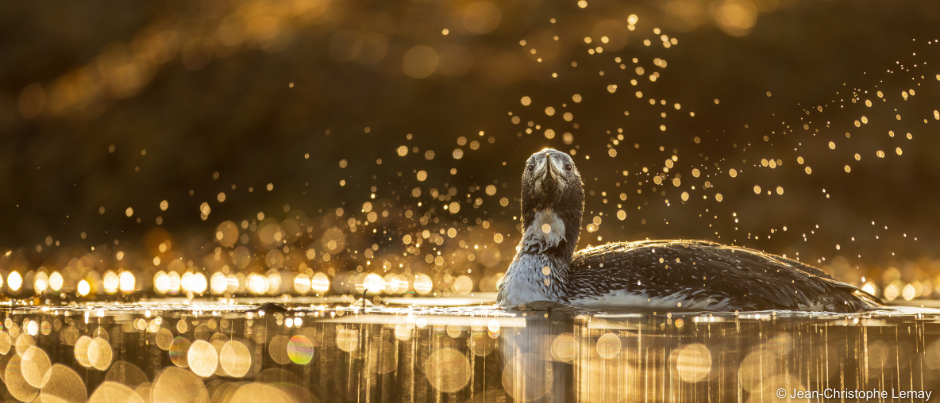The Québec maritime Blog

-
Îles de la Madeleine
Jean-Christophe Lemay
Taking Wildlife Photos on Vacation: A Few Tips from a Nature Photographer
Who hasn’t wanted to meet the gaze of a charismatic red fox or admire magnificent humpback whales?
Québec is home to many spectacular landscapes and lush natural environments. In vast forests, on high mountain peaks or in the cold waters of the Estuary and Gulf of St. Lawrence, you’ll find a rich, diverse and exciting variety of wildlife species. With a little patience and observation, you can encounter and photograph majestic animals in every maritime region of Québec. Over the past 10 years, I’ve had the privilege of exploring this magnificent territory and photographing a wide range of wild animals and spectacular scenes. Based on my first-hand experiences during these outings, here are a few practical tips to optimize your chances of having great encounters with Québec’s wildlife and capturing unique photos!
Go out at sunrise or sunset

To maximize your chances of taking amazing photos of wildlife, you’ll sometimes have to get up early! It’s the best time of day for so many reasons: fewer people on the trails and therefore less disturbance of wildlife, beautiful light for a muted atmosphere in your photos, and active wildlife spcies! A large proportion of Québec’s wildlife is crepuscular and therefore on the move at dawn or dusk. This is particularly true of mammals such as moose, white-tailed deer, snowshoe hares, etc. Of course, you may also encounter these species in broad daylight! For example, the magnificent black bears found in Forillon National Park in Gaspésie can often be seen in the middle of the afternoon, filling up on grass before taking a nap in the shade of the forest!
Spend time along the shores of the St. Lawrence

The majestic St. Lawrence bustles with marine life of all kinds! A simple stroll along the shoreline in Côte-Nord offers not only incredible panoramic views, but also opportunities to observe marine mammals such as minke whales and even humpbacks! Of course, it’s a good idea to take the time to stop at key locations along the Whale Route to enjoy the show to the fullest. For example, a stop at the Cap-de-Bon-Désir Interpretation and Observation Centre will give you the opportunity to simply sit on the rocks, camera ready and battery fully charged, to photograph the whales! Pro tip: the atmosphere at sunrise is fantastic!

Are you more interested in seabirds? The best times of year to observe them are during the spring and fall migrations. But you can also check a few species off your list in midsummer! The many islands in the St. Lawrence Estuary provide resting and nesting areas for a host of bird species, including common eiders and black guillemots. And what about the Atlantic puffin colonies in the Mingan Archipelago in Côte-Nord or the northern gannets on Bonaventure Island in Gaspésie? Both are true paradises for birders, wildlife photographers and nature lovers!
Visit national parks

There are many advantages to visiting national parks to observe beautiful wildlife species. Because these territories are protected (and hunting is prohibited), animals generally feel safer and less nervous, as is the case with the white-tailed deer in Parc national du Bic in Bas-Saint-Laurent. These large conservation areas have also been established because of their rich or unique biodiversity, making them excellent starting points for an immersion in Québec’s natural environments! Of course, to increase your chances of taking good photos, you should always remain quiet and unobtrusive, wherever you are, whether in a national park or not. Even if some wildlife species seem completely unperturbed by your presence, they’re always on the lookout for the slightest movement and can be startled at any moment. Patience and respect are your best allies for a successful nature outing. And don’t forget to find out what species you’re likely to encounter before your visit. Coming across a moose in the mountains of Parc national de la Gaspésie when you least expect it can be a real surprise!
Chat with guides and locals

There will always be people who have more experience or better knowledge of the terrain than you do, no matter what region you visit! Whether it’s your guides in national parks or the people who have lived and worked in the area for years, a quick chat can often provide valuable information. I’m thinking, for example, of the friendly and welcoming residents of the Îles de la Madeleine, a real paradise for birds, seals and foxes (and just in general, in fact). Without necessarily revealing their biggest secrets or the most sensitive places, locals may be able to tell you the best beaches to visit or the most recent wildlife sightings in the area, and thus increase your chances of getting some amazing photos. And in any case, it’s always great to chat with locals and regulars!
I hope these tips will help you take great photos of the wildlife that inhabits the maritime regions of Québec. Don’t forget your camera and a ton of SD cards! Happy exploring!

(0) comment